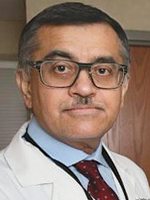It’s late summer in Milwaukee. South 27th Street is slick after a morning rain shower and Dinesh Jhunjhnuwala (Jhun-jhun-wala), vice chairman of S. Chand & Co., one of India’s largest and oldest publishing companies, sits behind a table in the physician office building at Aurora St. Luke’s Medical Center.
Weather reports say it’s been raining nearly 7,400 miles away in New Delhi, too. That’s where Jhunjhnuwala lives. He wears thick-rimmed black glasses, a maroon Hugo Boss polo shirt, a silver watch with a leather band strapped around his left wrist. His black mustache has a few patches of gray.

In two days, he will turn 56.
“In India, you have fantastic physicians, and lately they’ve built a lot of new and nice, modern hospitals,” he says. “But somehow, I don’t know. There’s something lacking there.”
The Milwaukee metropolitan area is one-sixteenth the size of the New Delhi metro area. Before he bought his first plane ticket to General Mitchell International Airport in 2009, Jhunjhnuwala said he wouldn’t have been able to find Milwaukee on a map. But now, it’s a place he, his family and a growing network of friends and business associates have been traveling to frequently for medical care.
They’re not alone.
This year, some 200 patients from around the world, many of them wealthy executives from Hong Kong, India, Italy, Malaysia and Saudi Arabia, will travel to St. Luke’s for check-ups, tests and diagnoses. That’s up from 45 foreign patients in 2012.

There were zero in 2008.
Over the past seven years, Aurora Health Care has quietly been expanding its brand globally.
Called the Global Executive Program, it is still in its infancy compared to the vast international reaches of similar programs run by the prestigious Mayo and Cleveland Clinics, and several others around the country. But Aurora’s decision to venture into the international market signifies a shift in its long-term strategic plan – one that involves transforming itself from a local to a national brand that pulls patients from around the world.
Beating at the center of this plan is a renowned heart specialist St. Luke’s hired away from the Mayo Clinic in 2009.
His name is Dr. Bijoy Khandheria.
‘All roads lead to Dr. Khandheria’
Khandheria, medical director of the Global Executive Program, is a short man with a thin mustache and gray hair around his temples. It’s a Friday afternoon. He’s wearing a white lab coat over his shirt and tie. He discusses his history with Aurora while waiting for the results of a biopsy taken from an Italian patient that morning.
“In the six years or seven years I’ve been here, I’ve seen Aurora move in a really well-orchestrated fashion,” Khandheria says. “We used to talk about being a local Wisconsin provider. Now, our strategic plan says we want to be a national brand and an international brand.
“Our governing board and our senior leadership has sort of said, ‘Now we have our foot well-positioned in Milwaukee and in Wisconsin … we also want to see if we can expand what we can do for Wisconsin to other states and other countries.’”

Though he has lived in the U.S. for decades, Khandheria was born and raised in India. That’s also where he began studying medicine.
In 1979, Khandheria received his master’s degree in pre-medicine from the Maharaja Sayajirao University of Baroda.
Baroda, now called Vadodara, is a city of more than 2 million people in the western Indian state of Gujarat near the mouth of the Mahi River.
Gujarat is the birthplace of famed Indian civil rights and independence leader Mohandas Gandhi. “Baroda” was an anglicized version of the city’s name used by English merchants. In 1974, as Khandheria was beginning his studies, the city renamed itself.
Its new name is rooted in an ancient Sanskrit word that means “in the heart of the Banyan tree,” a species of fig tree that is considered sacred in India for, among other things, its prolific growth pattern and its medicinal properties – a good omen for a young Indian doctor at the beginning of his career.
Khandheria left Vadodara in 1981 and moved to the U.S., where he completed residency programs at Saint Agnes Medical Center and Hahnemann University Hospital in Philadelphia. In 1984, he began a cardiovascular disease fellowship at the Mayo Clinic Graduate School of Medicine. He remained with the prestigious health care system for 27 years.
Then, in 2009, Aurora began poaching cardiovascular physicians and ultrasound imaging technicians from the Mayo Clinic. It was a combination of experience Aurora needed at the time to improve its catheter-based cardiovascular surgeries.
When Aurora began courting Khandheria, he was chair of the Mayo Clinic’s Division of Cardiovascular Diseases. He was also chair of Information Technology, directing the entire Mayo Clinic organization’s IT infrastructure.
Aurora convinced Khandheria to move to Milwaukee, where he was soon followed by several others. And when he came, he brought something else with him that Aurora leaders recognized could be very valuable as they began planning for the future: a handful of loyal international patients.
Khandheria had developed strong relationships with them over years of tests, surgeries and checkups at Mayo. They were unwilling to part ways with their American doctor.
“In 2009, when Dr. Khandheria was joining Aurora, he notified us some patients might be interested in following him,” said Judy Beiler, a registered nurse and director of Aurora’s Global Executive Program.
Beiler was the earliest addition to what is now Aurora’s Global Executive team. She had years of experience working with different departments in the Aurora system and was asked to help Khandheria develop medical test and examination itineraries for his international patients – a tricky thing to do when the patients are only in Milwaukee for a short window of time, often just two or three days.

“I believe Aurora was interested in it, and perhaps did not have a true plan, but because we were bringing Dr. Khandheria on board for other programs, and this population was with him, we decided to kind of capitalize on that opportunity,” Beiler said.
Like a Banyan seed landing on the branch of an existing tree, Khandheria’s international patients germinated into the root structure of Aurora’s Global Executive Program.
Jhunjhnuwala was one of them.
“It’s a chain which has just been growing,” Jhunjhnuwala said. “We have referred a lot of friends and relatives here. No disrespect – Mayo is way up there in a lot of things, and they still hit really high scores, but I think those suddenly have become meaningless to us. Today I wouldn’t think of going anywhere else. (As long as) Dr. Khandheria is here, I am here. Simple as that.
“All roads lead to Dr. Khandheria. That’s my mantra.”
A window of opportunity
India’s hospital infrastructure has improved significantly over the past decade and is positioned for rapid growth over the next four years. The value of its health care industry, currently estimated at more than $100 billion, is on track to more than double by the end of 2020, according to the India Brand Equity Foundation, a trust established by the Indian government to study economic trends.
Back in the Aurora physician office building, Jhunjhnuwala explained why, despite the impressive growth of India’s medical system, he has chosen to fly across the world to a working-class neighborhood on Milwaukee’s south side to undergo a series of routine medical tests.
“Maybe it’s because the population has gotten so big and there are so many patients,” he said. “You just feel like you’re just one guy in a big ocean. Whereas here, you feel a lot more connected and you feel more exclusive care is being given to you. So even though it’s a lot more costly; a lot more troublesome flying all the way, and so on and so forth – and you’re away from your family – somehow the ease and the comfort you feel here, you just don’t get there.”

Timely and thorough appointments are hard to come by in India, he says, even if hospital executives or doctors are personal friends. In New Delhi, Jhunjhnuwala helps run a rapidly-growing publishing company. S. Chand has 2,000 employees and 110 offices. The organization sells tens of thousands of textbook titles to 40,000 schools and educational institutions throughout South Asia, Southeast Asia, the Middle East and Africa. It’s estimated around 20 million students learn from textbooks published by S. Chand.
Jhunjhnuwala met Khandheria in 2000, when the physician oversaw his father’s first bypass surgery at the Mayo Clinic. Each year since, Jhunjhnuwala or one of his four brothers has accompanied their father on an “annual pilgrimage” to the U.S. to see Khandheria.
They receive checkups themselves while they’re here.
“I was kind of surprised that the airport was relatively not big compared to (other) major cities, but the flip side to it is that the city is good,” Jhunjhnuwala said of Milwaukee. “We really like our stay here, no matter how short or long. We’ve visited downtown and done a little bit of sightseeing here and there.”
In addition to India, St. Luke’s international patients tend to come mostly from Hong Kong, Italy, Malaysia and Saudi Arabia. Executives also have started coming from Ireland, Russia, England, Qatar, Kenya and dozens of other nations.
Even foreign doctors, including German Guzman, a 37-year-old geriatrics and public health physician from Oviedo in northern Spain, now come to St. Luke’s.
“I travel every year to St. Luke’s,” Guzman wrote from Spain in an email. “Usually, I go there to do a general check-up.”
Guzman has been coming to Milwaukee since 2009. Along with Jhunjhnuwala, he followed Khandheria to St. Luke’s from the Mayo Clinic.
“I have seen how it has evolved,” Guzman said of Milwaukee. “It is a great city to visit. Every time I return to Milwaukee, there are new restaurants, new hotels and new buildings.”
Milwaukee feels friendly and comfortable, he said, putting him at ease while undergoing medical tests. He also likes receiving treatment in the area because it has a close cluster of medical research programs using cutting-edge equipment.
“In the USA, and in Milwaukee, there is a lot of research going on compared to any other country in the world,” Guzman said. “You always know that you are getting the best and more up-to-date assessment.”
Finding a place in the market
Entering the international market is a daunting task. Many international patients, especially those traveling to the U.S. for the first time, are unfamiliar with the American medical system and rely heavily on hospital rankings from organizations such as U.S. News & World Report to decide where they should receive care.
High on those lists, usually duking it out for No. 1, are the Mayo Clinic and the Cleveland Clinic.

Both health care systems have longstanding reputations for excellence and began serving the international market decades ago.
The Mayo Clinic system has been building its reputation since the 1890s and the Cleveland Clinic was established in 1921. Hanover General Hospital became St. Luke’s Hospital in 1928, but Aurora Health Care has only been around as a system and brand since 1984.
When Aurora began building its Global Executive Program, both the Mayo and Cleveland clinics were already attracting thousands of patients from more than 100 countries.
But based on its growth, Aurora leaders feel comfortable there is an opportunity to expand and carve out a niche in the minds of patients abroad.
“We’ve had a lot of patients that have been referred to us for a multitude of different health needs,” Beiler said. “It’s been a great ride, I’ll tell you that. As the program has grown, we realized there were things we needed from a staff perspective.”
Over the past few years, Aurora added a business coordinator to keep track of patient accounts, plus a small staff of nurse practitioners and a physician’s assistant to help coordinate complex regimens of tests and care for international visitors, often spanning several fields of medicine, that must be completed in very short windows of time.
The hospital system also completed a build-out and renovation of its “Global Executive Suite” on the fourth floor of St. Luke’s in 2015. The remodeling project, which was contracted through Building Service Inc., took nine months to complete. Granite, architectural glass, decorative tile and new light fixtures were added, as were art pieces and high-end furniture.
On its website, BSI said of the project: “Our client desired a private environment for prestigious guests to receive the best care for their ailments while resting comfortably with loved ones in a pampered, high-class environment. The existing Global Executive Health Suite, completed in 2009, was expanded to include two additional exam rooms, a lounge space, dining area, private bathroom, and an additional space for the physician’s assistant.”
According to City of Milwaukee building permits, Aurora paid BSI a total of more than $680,000 between Dec. 4, 2013 and Oct. 23, 2015 for improvements at St. Luke’s Medical Center. The health care system paid BSI $160,000 in October 2009, the year the original suite for international patients was first completed.
Overall, Aurora spent more than $25.6 million on renovations and alterations at its multiple facilities located within the city of Milwaukee between March 23, 2012 and Aug. 31 2016. Of that money, more than $21.3 million was spent specifically on renovations and alterations at St. Luke’s Medical Center at 2900 W. Oklahoma Ave.

Brad Kruger, vice president of operations at St. Luke’s, said he expects the Global Executive Program to grow incrementally through recommendations from existing patients. Aurora has invested little in advertising for the program, he said.
“We’re also contracted with some countries for care overseas and continue to expand,” Kruger said. “We’re contracted with the country of Norway (to treat) high-end brain cancer.”
In addition to its Global Executive Program, Aurora has begun hosting delegations from foreign nations regularly and negotiating deals – such as its contract to perform complex neurosurgery on Norwegian citizens – with foreign health ministries.
Representatives from Denmark’s Ministry of Health, doctors and administrators from the Chen Zhou First People’s Hospital in China, the prime minister of Myanmar, representatives from Saudi Arabia’s University of Dammam, as well as physicians from the Philippines, Brazil, Kenya and Nigeria, all have come to Milwaukee to tour St. Luke’s and share best practices in recent years.
Some foreign dignitaries also have been patients at St. Luke’s, such as Sheikh Hamad bin Khalifa Al Thani, former Emir of Qatar, whom Khandheria said donated more than $2 million to the hospital system in the past few years to assist in setting up a laboratory to conduct research on extending the life of heart cells after heart attacks and other traumatic cardiac events.
Despite its name, the Global Executive Program isn’t limited to foreign patients. Patrick Byrne, founder and chief executive officer of Overstock.com, former Wisconsin Gov. Martin Schreiber, and local restaurateur Joe Bartolotta are among the U.S. citizens who have used the service.
Aurora also doesn’t host the only international program in the Milwaukee area. Wauwatosa’s Children’s Hospital of Wisconsin and Froedtert Health formed a partnership in 2014 called the Wisconsin International Patient Program to attract patients from around the world.
CHW treated international patients before the partnership was formed, a representative said. Between the patients it’s served through the WIPP since 2014 and its own access center since 2013, the hospital has treated 43 international patients from 20 different countries. A Froedtert representative estimated the hospital network has treated nearly 100 patients from overseas through the WIPP between 2014 and 2016.
These pushes from the Milwaukee area’s largest health systems to attract more international attention have come at a time when local investment in medical research also is on the rise.
Froedtert & the Medical College of Wisconsin announced plans this summer to build an athletic performance research center at the new Milwaukee Bucks practice facility under construction in the Park East Corridor.
In January, Aurora announced it had committed $40 million to Marquette University to help build its planned $120 million athletic performance research facility on 12 acres of vacant and underused land east of Marquette’s campus along West Michigan Street. It’s a facility Marquette researchers say they are hoping will become a national destination for sports medicine research.
Wauwatosa’s Medical College of Wisconsin also has established itself over the past few decades as a hub for blood and bone marrow transplant research. Since 2001, the National Institutes of Health has given the Medical College 19 grants totaling $109.4 million to support its unique and extensive clinical trial and patient outcome database, used internationally for marrow and blood transplant research.

The health care system’s proximity to GE Healthcare gives it easy access to advanced diagnostic imaging and radiology equipment, as well as improved medical software. The medical equipment manufacturer also partners with administrators and physicians at local hospital systems, such as Aurora, to develop and tweak its product designs.
“This is still a very big secret in the country,” Khandheria said of Aurora’s Global Executive Program and its collaborations to expand its network. “Most of our referrals are through word-of-mouth. But the word-of-mouth is starting to build momentum.”
It helps that Wisconsin health systems began collaborating broadly in recent years, forming the Integrated Health Network and the About Health network to share data and information on best practices. The Integrated Health Network is a partnership among Agnesian Healthcare, Columbia St. Mary’s, Froedtert Health, Hospital Sisters Health System, The Medical College of Wisconsin, Ministry Health care, SSM Health and Wheaton Franciscan. The About Health Network includes Aurora, Aspirus, Bellin Health, Gundersen Health System, ThedaCare and UW Health.
“However big you are, you can’t be the best at everything,” Khandheria said. “So if you collaborate with the right people, you can get best practices … Then for the State of Wisconsin and patients of Wisconsin, you are now providing the best of breed rather than generic care.
“I take that to the next level. Whatever we are doing, if we can provide that to Wisconsin, why not to Illinois? Or neighboring states?
“Or any other country?”

